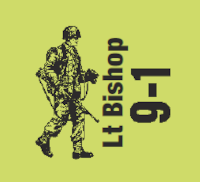
From time to time, people have asked that I write an article covering Fire Lanes. For players coming from ASL Starter Kit, I imagine the complex simplicity of Fire Lanes might be a little tough to understand. There is no concept of Fire Lanes in Starter Kit ASL. Yet many ASL Grognards will tell you a well placed Fire Lane can be a key aspect of a well-organized defense. A Fire Lane’s ability to deny the attacker usage of terrain, coupled with the Fire Lanes ability to attack repeatedly, cannot be overestimated. Fire Lanes sow doubts into the attackers mind. As a defender, any time you cause the attacker to reconsider you also give him a chance to make mistakes. And mistakes represent defensive opportunities and the chance for you to seize the initiative.
Let’s look more closely at Fire Lanes to see how they work in ASL.
Rules Dive
Placement
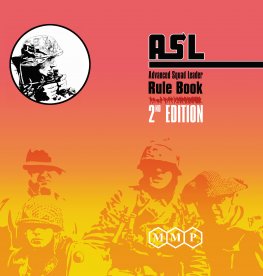
Rule A9.22x covers Fire Lanes. The section of rules is not that long but there are some key bits to understand. A Fire Lane is a special form of Residual Fire Power. Only Good Order units or Support Weapon MG which do not Cower can place Fire Lanes. A MG manned by an SMC is not Good Order, nor is a MG subject to Ammunition Shortage. Only unpinned Infantry may place a Fire Lane and the MG may not be already marked with a First Fire or Final Fire counter. The manning Infantry may be marked with a First Fire counter, but if so marked, may not apply its Inherent FP as part of an attack to place a Fire Lane. Such an attack would be Sustained Fire (A9.3) and the MG covered with a Final Fire counter as part of this attack.
Fire Lanes are places along the “same level” or along a “continuous slope” (B.5). Fire Lanes have “directionality” meaning you can trace an LOS from the origination to the target Location. As such, DRM never reduces the RFP of a Fire Lane. The DRM applies to the Fire Lane attack instead. Leadership or Heroic DRM do not apply to a Fire Lane RFP attack although they may affect the attack that initially places a Fire Lane.
Fire Power
The Fire Power of a Fire Lane is determined by shifting one column left on the IFT from the MG’s raw Fire Power. A .50 MG has a raw Fire Power value of 8 and would place a 6 Fire Power Fire Lane. A Russian LMG has a raw Fire Power of 2 and would place a 1 Fire Power Fire Lane. Fire Lane counters can be placed out to the range limit of the MG placing the Fire Lane. For placement of this special Fire Lane counter, so-called “soft hindrances” do not affect placement of the Fire Lane counter.
Fire Lane Attacks
Once placed, a Fire Lane attacks units entering a Location where the MG exerts RFP. Cross reference the Final IFT DR onto the attack column and apply the result to the unit entering the Location. Apply DRM normally with some exceptions. As noted earlier, Leadership and Heroic DRM do not apply to Fire Lane attacks. “Soft Hindrances” (SMOKE, brush, grain, marsh, FFE, LV, DLV, Dust, Huts; A9.22) only cancel FFMO, they do not otherwise apply. “Hard Hindrances”–those not specifically “soft Hindrances”–apply normally. We will see examples of this soon.
A Fire Lane attack never Cowers. If a unit successfully places a Fire Lane and Cowers on another First Fire Attack elsewhere, the Fire Lane is not canceled. A unit which has successfully placed a Fire Lane and is marked First Fired may Subsequent First Fire only as part of a Triple Point Blank Fire opportunity. A unit which could not SFF in this manner can Final Fire normally during the Defensive Fire Phase.
Fire Lane RFP does not stack. Fire Lane RFP does not stack with normal RFP either. If both forms of RFP exist in the same Location, normal RFP attacks first. If more than one MG exerts a Fire Lane into a Location, they attack separately. The Fire Lane owner determines which Fire Lane attacks first. Keep this ordering in mind. If an RFP attack eliminates a unit, no other RFP attacks are made. Since Fire Lane attacks subject the placing MG to normal Malfunction rules, Eliminating a unit with normal RFP spares the MG a breakdown risk. If normal RFP does not Eliminate the unit, roll the least likely to break Fire Lane attacks first.
Cancellation Of A Fire Lane
Cancel Fire Lanes when a unit takes a TPBF opportunity. Pinning, Breaking, or Eliminated the placing unit also cancel a Fire Lane. An AFV ending its MPh in the same Location as a unit placing a Fire Lane, also cancels the Fire Lane.
An unarmored unit possessing no PRC does not cancel a Fire Lane by ending its turn in a placing unit’s Location. An armored AFV without Vulnerable PRC passing through a placing unit’s Location also does not cancel a Fire Lane.
Example, Impulse One
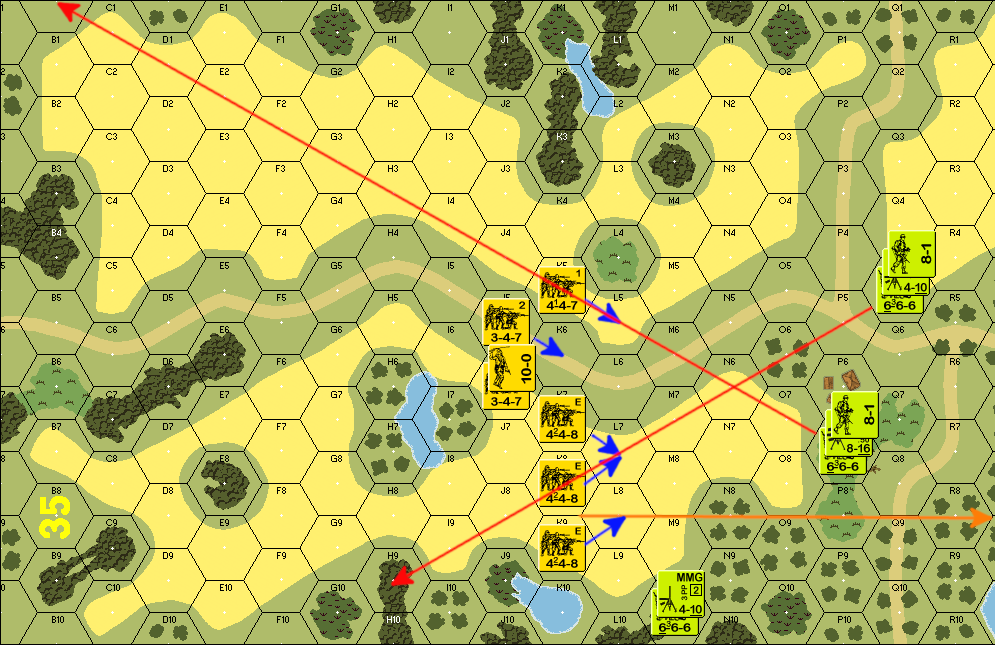
Refer to Figure 1. It is the Japanese Movement Phase and they declare an alternate grain Banzai attack along the orange arrow. The American unit in P7 is the declared target and the American unit in M10 is HIP. Blue arrows show the movement after the First Impulse. After completion of the First Impulse, the unit in P7 attacks L5 and declares a Fire Lane. The attack is +2 DRM for Kunai Hindrances, -1 for Leadership, and -1 for FFNAM. The initial attack is 12 +0. Recall that “soft hindrances” do not affect placement of a Fire Lane counter. Even though there are enough Hindrances to block LOS out to B0, place a 6 FP Fire Lane in B0. The squad exerted 6 FP into L5 which places 2 RFP reduced 2 columns for the Hindrances in N6 and O7. So no RFP from the squad.
The American unit in Q5 declares an attack to place a Fire Lane and opts not to use the squad’s Inherent Fire Power. The leader will Direct the attack to avoid cowering and the initial attack is 4 +1. Again, “soft hindrances” do not affect placement of a Fire Lane counter so place a 2 FP Fire Lane counter in H9. Mark the leader and MMG with a First Fire counter.
Impulse 2

Refer to figure 2. Again, blue arrows represent movement. Upon completion of the Impulse, resolve all normal Residual Fire Power attacks first, followed by Fire Lane attacks. There are no normal Residual Fire Power attacks here. Attack the 3-4-7 in L5 with a 6 Fire Power Fire Lane attack tracing LOS to the .50 in P7. Recall that “soft” Hindrances have no effect other than to cancel FFMO. This attack would be a 6 -1 (FFNAM). Attack the 4-4-8 in M7 with a 2 Fire Power Fire Lane attack tracing LOS back to Q5. This attack passes through a “hard” Hindrance in O6. This Hindrance applies a +1 DRM in the normal manner. The attack against the 4-4-8 in M7 is a 2 +0 shot.
The HIP unit in M10 reveals itself, attacking the 4-4-8 in M8. It also declares a Fire Lane as part of this attack. The attack against M9 is 20 -1. If the American does not Cower, place a 2 Fire Power Fire Lane counter in M3. Assume it does not cower. Recall that units using Impulse Movement are subject to Fire Lanes in the Impulse in which the Fire Lane is placed. As such, attack all units in M5, M7, and M8 with a 2 -1 Fire Lane Attack in this Impulse. All of those Locations are attacked with a separate IFT DR. Also remember that if any of those Fire Lane attacks roll doubles the attack does not Cower nor does such a roll negate the Fire Lane. The American Squads in P7 and M10 cannot Subsequent First Fire since there is no TPBF opportunity.
Impulse Three
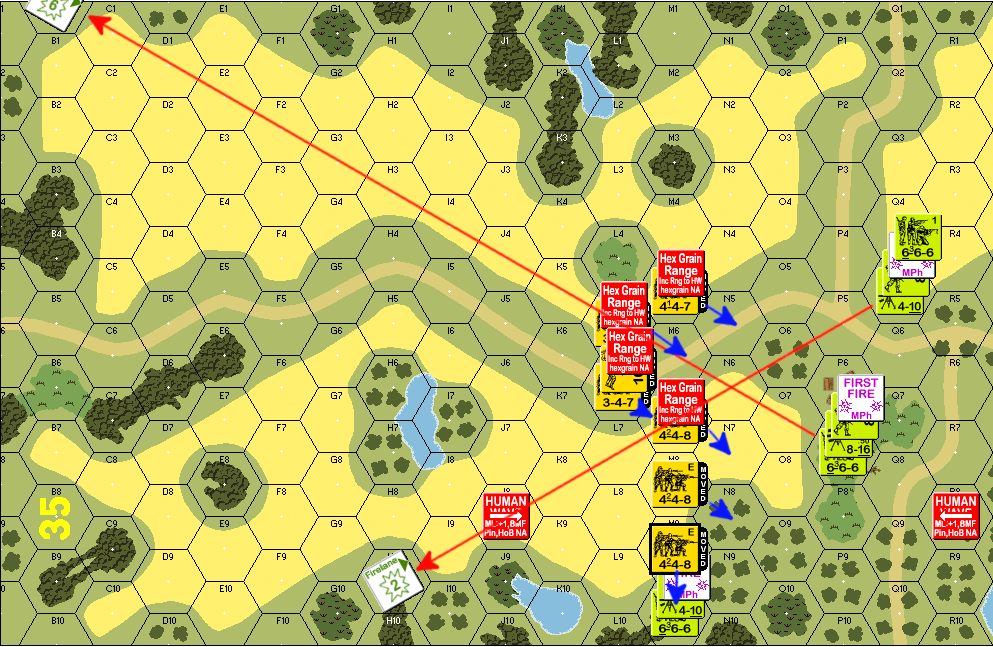
Refer to figure 3. The Japanese unit in M9 moved into M10. This represents a TPBF opportunity and immediately cancels the Fire Lane out to M3. No units are attacked by this Fire Lane. There is no “normal” RFP so Fire Lane RFP attacks next. I presented the DRM and reasoning for those in Impulse 2 so I will not rehash those here. The American unit in Q5 can fire at N5 with its Inherent FP since it is not marked First Fired. It now takes a 6 -2 into N5. Even should it Cower on this attack, the Fire Lane remains in place and is unaffected.
I am going to end this example here since it showed so many of the principles I wanted to cover. There are a couple of other examples I wanted to touch on so let’s leave the PTO for now.
Example Two
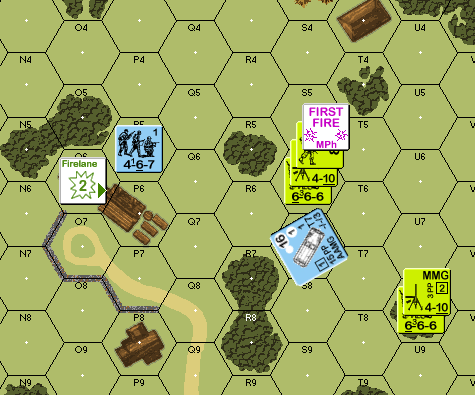
Refer to figure 4. The American unit in S6 has placed an Alternate Grain Fire Lane to the “bottom” of the hex grain exerting 2 Residual Fire Power into 06, P6, and Q6 and 4 Fire Power (Point Blank) into R6. The Germans wish to cancel this Fire Lane by moving the halftrack into S6. The American unit in U8 attacks and declares a Fire Lane as part of this attack. Since To Hit DR never cower (A7.9), place a Fire Lane Counter would in O5 provided the MG did not Malfunction. Assume the halftrack was Stunned and the original Fire Lane remains in effect.
Now the German Infantry Moves using Assault Movement. If it moves into O6, The original Fire Lane attacks and would be a 2 +2 attack. Instead, assume it opts to move into P6. Here the Americans have an option. They could opt to attack the unit in P6 normally for a 2 +2 attack. Alternatively, they could opt for a Fire Lane Snap Shot (A9.221) attacking along the P6/P5 hexside for a 2 +0 attack. If they opt for the Snap Shot attack, the Germans would still gain Control of P6 and the P6 Building even if the unit is Pinned, Broken, or Eliminated.
Also note that Snap Shots are only an option for Alternate Grain Fire Lanes. Even though the German Infantry is moving out of the second Fire Lane, it can not affect it.
Conclusion

It has been a while since I last wrote anything. I hope this finds you happy and in good health. For those of you well versed in Fire Lanes, please leave a comment below so others might benefit from your knowledge. This article is not comprehensive. I have covered Fire Lanes and Slopes in my series on Slopes. Fire Lanes across Deirs and Hillocks–as well as those placed from Inside or On Deirs and Hillocks–are a different animal as well. I tried to focus on the fundamentals here and if there is demand, I will move on to the edge cases in a later article.
I hope everyone has a good rest of the week and a good weekend. If I am slow to respond it is because I will be out of town for the next ten days. I hope you can forgive me. Until next time.


I am confident in one thing: I mess up firelanes more often than anything else in ASL.
One question: would a German LMG leave a FP 1 or FP 2 firelane? I’m thinking 1 because of the line “FP normally used by that MG” (or words to that effect).
Thanks!
It would use one column to the left of what it normally attacks on. A German LMG attacks on the 2 column so it leaves a Fire Lane on the 1 column. — jim
Thanks! I got it right!
Should “If it moves into O6, The original Fire Lane attacks and would be a 2 +2 attack.” read “If it moves into O6, The original Fire Lane attacks and would be a 2 -2 attack.” Regardless, another great article, thanks!
Hex O6 is a wooden building. It is hard to see under the FL counter. — jim
The last Snap Shot possibility for the Alternate Hex Grain FL should be a 2+0 and not a 1+0 I think due to the exception in A9.221.
[EXC: the Snap Shot is NA if that Fire Lane has already attacked that unit in the Location it is exiting; the Snap Shot FP of a Fire Lane is not halved as Area Fire].
This was correct earlier on a comment from Steve Pleava. It is possible you retrieved a cached version of the original document or downloaded an earlier version of the PDF. — jim
I enjoyed the article. I especially liked that you touched on which Residual attacks first, and when cowering does/doesn’t affect the fire lane.
Thanks Michael. — jim
“The American unit in Q5 has a Subsequent First Fire Opportunity in N5 since it not marked First Fired. It now takes a 6 -2 into N5. Even should it Cower on this attack, the Fire Lane remains in place and is unaffected.”
You meant the Q5 unit has a ‘First Fire’ opportunity with its inherent firepower since only the MMG ‘First Fired’?
Correct. I fixed the article. Thanks for catching my error.
Is a firelane affected by an orchard road? If I have an American MMG shooting down a straight road seven hexes long – all of the white centre dots are within the confines of the road, but two of the hexes are also orchard roads, is the firelane worth two FP for its entire length? Thanks.
The shot would not be affected by the Orchards (e.g. there would be no “hard” hinderance). So the shot would be a 2FP attack out to the limit of the MMG’s range. WRT DRM, that would depend on how the unit moves. If it is crossing a road hexside AND using the Road Rate, then FFMO would apply. If it were traveling along the Road using other than Road Rate (using the Orchard entry cost) then FFMO would not apply.
🙂 Excellent, many thanks.
Hi Jim,
i think you refer to FFMO, not FFNAM abour orchard/road question 😉
Laurent
You are correct. Fixed and thanks for catching that.
Hi ! I don’t usually comment, but before asking my question, just a quick thank you for the website and all the great articles, always a big big help when refreshing rules after a long time 🙂
Quick question though about the following sentences : “The HIP unit in M10 reveals itself, attacking the 4-4-8 in M8. It also declares a Fire Lane as part of this attack. The attack against M9 is 20 -1. ”
Phrasing like that, it seems to imply you can attack M8, declare a Fire Lane and also subsequently attack M9 with a 20-1.
The attack against M9, would it be more in the case you choose to reveal your HIP against the M9 move and not M8’s one ?
In this case, to check if I understood : when the 4-4-8 moves to M9, you would reveal your HIP unit in M10 for a 20-1 attack on M9, then also declare a 2FP Fire Lane up to M3 (with a 4FP in adjacent M9). Also, the M10 MMC would be First Fire, and leave on the M9 hex a 4 Residual FP for its own attack.
Would that be correct ? 🙂
Thanks a lot in advance, and thanks for your work !!
You cannot attack the unit in M9 with the Fire Lane and the initial attack. Attack it with the 20 -1.
When to reveal is always a question. You have to remember most of examples are contrived to make a point. I don’t claim the examples are tactically sound when I am explaining the rules.
The Residual on M9 would be 6 since the squads FP would be doubled point blank. — jim